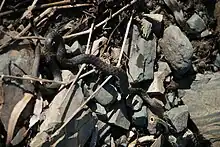Tropidonophis mairii
The common keelback (Tropidonophis mairii), also known as Mair's keelback,[2] is a species of nonvenomous snake in the family Colubridae. The species is endemic to Australasia.
| Common keelback | |
|---|---|
 | |
| Scientific classification | |
| Domain: | Eukaryota |
| Kingdom: | Animalia |
| Phylum: | Chordata |
| Class: | Reptilia |
| Order: | Squamata |
| Suborder: | Serpentes |
| Family: | Colubridae |
| Genus: | Tropidonophis |
| Species: | T. mairii |
| Binomial name | |
| Tropidonophis mairii (Gray, 1841) | |
| Synonyms[2] | |
Etymology
The specific name, mairii, is in honor of "Dr. Mair", an army surgeon with the 39th Regiment of Foot, who collected the holotype.[3]
Geographic range
T. mairii is found in Australia, Indonesia, New Guinea, and Papua New Guinea.[2]
Description
Dorsally, T. mairii is olive, brown, or blackish, with small black spots, or with black crossbars anteriorly. Ventrally, it is lighter. The subcaudals and often also the ventrals are edged with black. The dorsal scales are strongly keeled, and arranged in 15 rows at midbody.[4]
T. mairii resembles some Australian venomous snakes, the taipans (genus Oxyuranus) and the rough-scaled snake (Tropidechis carinatus).
T. mairii rarely grows over 1 m (39 in) in total length (including tail).
Diet
Mair's keelback feeds mainly on amphibians and small lizards. It is one of the few snakes that can eat cane toads (Rhinella marina), up to a certain size, without being harmed.[5]
References
- O'Shea, M.; Parker, F. (2017). "Tropidonophis mairii". IUCN Red List of Threatened Species. 2017: e.T177521A21648393. doi:10.2305/IUCN.UK.2017-3.RLTS.T177521A21648393.en. Retrieved 19 November 2021.
- Species Tropidonophis mairii at The Reptile Database . www.reptile-database.org.
- Beolens, Bo; Watkins, Michael; Grayson, Michael (2011). The Eponym Dictionary of Reptiles. Baltimore: Johns Hopkins University Press. xiii + 296 pp. ISBN 978-1-4214-0135-5. (Tropidonophis mairii, p. 166).
- Boulenger GA (1897). "An account of the reptiles and batrachians collected by Dr. L. Loria in British New Guinea". Annali del Museo Civico di Storia Naturale di Genova 18: 694-710. (Tropidonotus mairii, pp. 703-704).
- Kilvert, Nick (1 November 2019). "The native animals that turn cane toads into tucker". ABC News. Retrieved 6 November 2019.
Further reading
- Cogger HG (2014). Reptiles and Amphibians of Australia, Seventh Edition. Clayton, Victoria, Australia: CSIRO Publishing. xxx + 1,033 pp. ISBN 978-0643100350.
- GRAY JE (1841). "A Catalogue of the Species of Reptiles and Amphibia hitherto described as inhabiting Australia, with a description of some New Species from Western Australia, and some remarks on their geographical distribution". Appendix E, pp. 422–449. In: GREY G (1841). Journals of Two Expeditions of Discovery in North-west and Western Australia, During the Years 1837, 38, and 39, Under the Authority of Her Majesty's Government. In Two Volumes. Vol. II. London: T. and W. Boone. 520 pp. (Tropidonotus mairii, new species, p. 442).
- Wilson, Steve; Swan, Gerry (2013). A Complete Guide to Reptiles of Australia, Fourth Edition. Sydney: New Holland Publishers. 522 pp. ISBN 978-1921517280.
